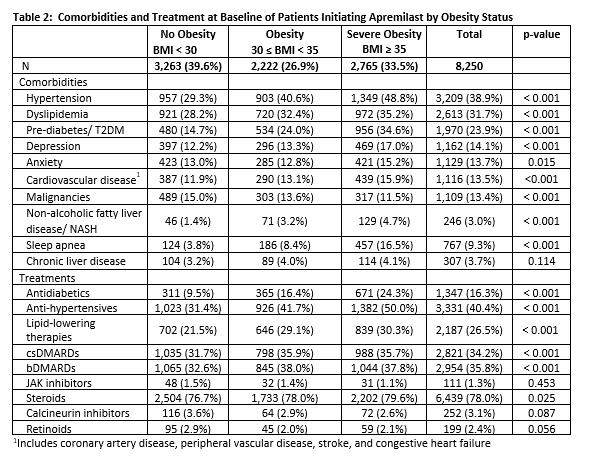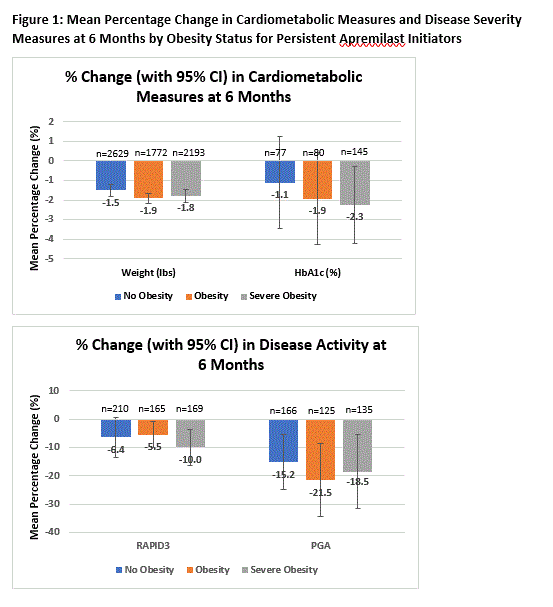Session Information
Session Type: Poster Session C
Session Time: 1:00PM-3:00PM
Background/Purpose: Obesity prevalence is higher in patients with PsO and PsA than the general population. Weight loss may improve PsO disease severity in obese patients. Clinical data suggest apremilast may be associated with weight loss and with reductions in HbA1c in patients. We describe changes in cardiometabolic parameters and disease activity outcomes over a 6-month follow-up period among PsO and PsA patients of differing obesity status newly treated with apremilast in a US-based real-world cohort.
Methods: We estimated the burden of obesity among patients with a diagnosis of PsO and/ or PsA newly initiating apremilast in the OM1 Real-World Data Cloud (including claims, electronic medical records, and lab measures) from March 2013 to November 2021. We stratified the study cohort by obesity status (no obesity, obesity [BMI ≥ 30 – 34.9], or severe obesity [BMI ≥ 35]). Eligible patients remained persistent on apremilast for 6 months. We described demographic and clinical characteristics, comorbidities, and treatments at baseline. Mean proportional changes in cardiometabolic measures (weight, HbA1c) and disease activity measures (RAPID3, Physician Global Assessment [PGA]) were assessed at 6 months. We used Wilcoxon Rank sum tests and Chi-square tests (for categorical variables) for comparisons by obesity status. Changes in cardiometabolic measures at six months were assessed using multivariable linear regression adjusting for age, sex, use of anti-hypertensives, lipid-lowering therapies, antidiabetics, steroids, and baseline outcomes.
Results: There were 8,250 PsO and PsA patients with outcome measures that initiated apremilast. The mean age was 55.2 years and 63.1% were female. 26.9% were obese and 33.5% were severely obese. Severely obese patients were younger (54.3) compared to those not obese (55.5), more likely to be female, with higher proportions identifying as Black (3.5%) and Hispanic (4.4%) versus patients who were not obese (2.1%, for Black, p < 0.001 and 3.6%, for Hispanic, p < 0.001) (Table 1). With increased obesity, there were higher proportions of patients with the following comorbidities: hypertension, dyslipidemia, pre-diabetes/ T2DM, depression and cardiovascular disease (Table 2). Patient and physician reported outcomes at baseline reflected mild to moderate disease severity. Mean raw RAPID3 score increased over increasing levels of obesity, 10.26, 12.17, and 12.49, respectively (p = 0.002). Mean PGA was similar across the strata. We observed significant reductions in weight (1.5%, 1.9% and 1.7%) across all strata and HbA1c (2.6%) for those with severe obesity. Disease severity outcomes reduced at 6 months regardless of obesity status (Figure 1).
Conclusion: This real-world study highlights the significant obesity burden among PsO and PsA patients. Similar to what has been shown in previous analyses, this study suggests apremilast may have beneficial effects on cardiometabolic measures in clinical practice including reductions in HbA1c in severely obese patients and reductions in weight and consistent improvements in PsO/ PsA disease outcomes across all BMI categories.
To cite this abstract in AMA style:
Orroth K, Cavanaugh C, Qian X, Kumparatana P, Klyachkin Y, Colgan S, Cordey M. Obesity Burden and Effects of Apremilast on Changes in Cardiometabolic Parameters by Obesity Status in Patients with Psoriasis (PsO) or Psoriatic Arthritis (PsA) in a Real-World Setting [abstract]. Arthritis Rheumatol. 2022; 74 (suppl 9). https://acrabstracts.org/abstract/obesity-burden-and-effects-of-apremilast-on-changes-in-cardiometabolic-parameters-by-obesity-status-in-patients-with-psoriasis-pso-or-psoriatic-arthritis-psa-in-a-real-world-setting/. Accessed .« Back to ACR Convergence 2022
ACR Meeting Abstracts - https://acrabstracts.org/abstract/obesity-burden-and-effects-of-apremilast-on-changes-in-cardiometabolic-parameters-by-obesity-status-in-patients-with-psoriasis-pso-or-psoriatic-arthritis-psa-in-a-real-world-setting/



